Weight-Training Exercises for Shoulders

Defined shoulders look great. Aside from their physical appearance, strengthening them is helpful for performing other exercises better, such as back exercises. Weight-training is the best way to work out your shoulders.
But working them out isn’t easy. Some people find the positions in shoulder exercises rather uncomfortable. In addition, incorrect execution can lead to painful injuries. In light of that, today we’ll look closer at weight-training exercises for shoulders.
Weight-training exercises for shoulders
You actually don’t need to do that many exercises for strong deltoid muscles. Let’s look at a list of exercises that make up a great weight-training workout.
Neutral grip overhead press
Some of the best shoulder workouts are seated. The neutral grip overhead press is a variation of a classic shoulder workout. To get started, sit down and grab your dumbbells. Raise your arms to the height of your chest.
In these exercises, make sure that both of your palms are always face-to-face. That position is the key variable that works out the front section of your deltoid muscles. Next, raise the dumbbells, extending your arms. Your elbows should be pointing slightly outwards.
Lift the weight by extending your arms and lower it by bending them. In the starting position, your dumbbells should always be in front of your chest while your arms should be completely bent.
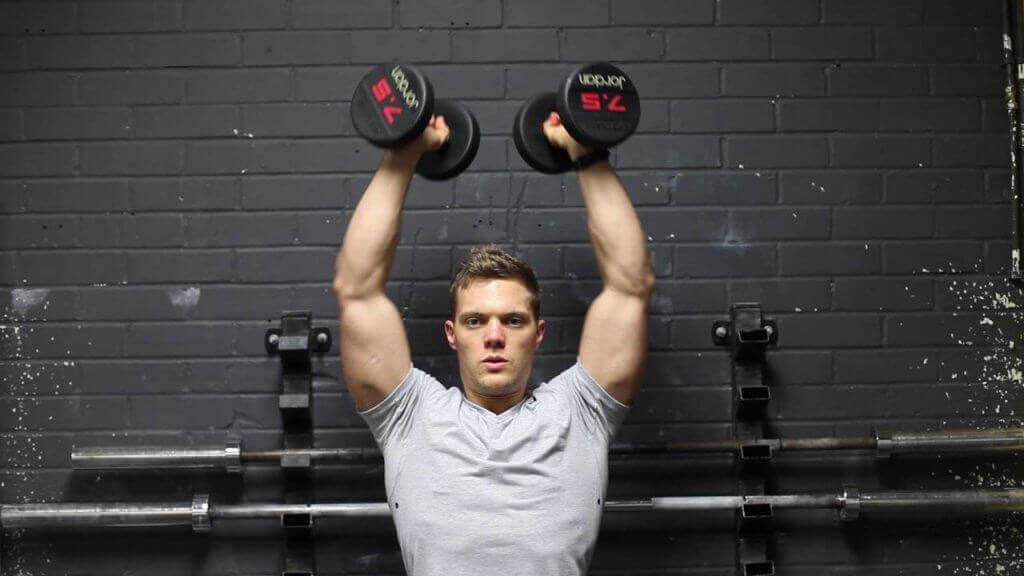
Dumbbell Arnold press
For the Arnold press, stay seated and in the same position as the previous exercise. The difference is in the position of your hands in relation to your dumbbells.
Here, both palms should be facing backwards. Think about the movement you make when you work out your biceps.
Start with your arms bent and dumbbells just above your shoulders. Next, lift them by twisting your wrists. When your arms are extended, your palms should be facing outwards.
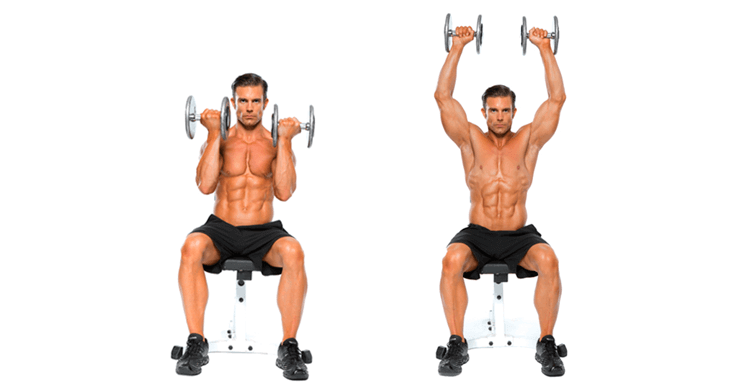
The advantage of this position and twist is that they allow you to almost entirely work out your deltoid muscles. It’s an integral exercise, unlike the traditional ones where the arms stay up and the shoulders only have a superficial workout.
Frontal lifts
Frontal lifts can’t be missing from your shoulder workout; it really focuses on the muscle set. Everyone has probably seen frontal lifts at some point or another in a gym.
To get started, stand up as straight as possible. In the starting position, keep the dumbbells lowered as you completely extend your arms. Try to keep them alongside your legs.
Next, raise your arms, keeping them as straight as possible and control the weight of the dumbbell. Raise and lower your arms, controlling both actions. This routine really builds the strength you’ll need to tackle your other shoulder workouts.
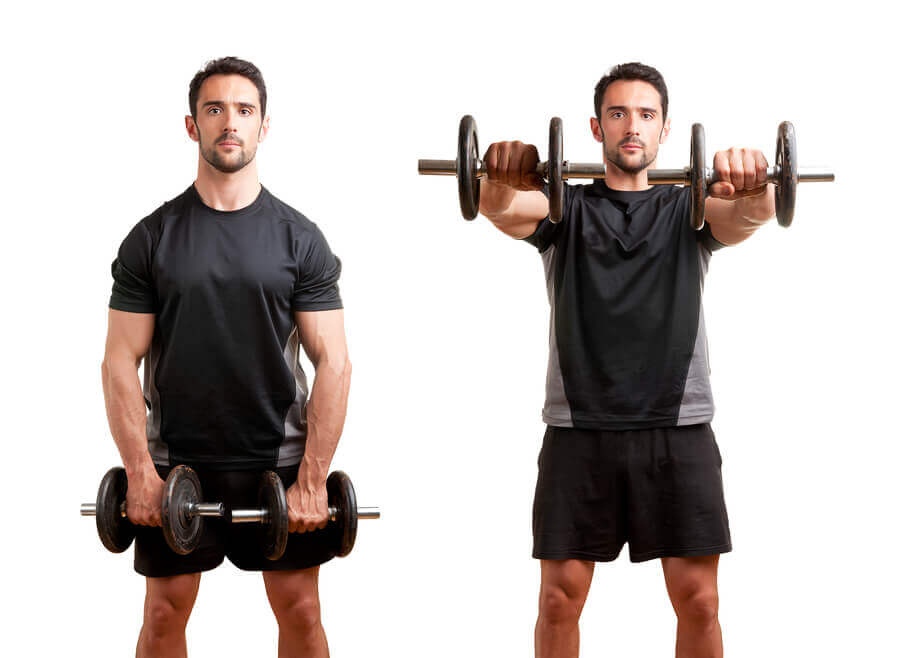
Lateral lifts with inclined core
Lastly, we have to include at least one exercise for the back of your shoulders. Skipping over the backside is a common mistake people make in their shoulder routines.
Start by leaning your core forwards and keeping it as straight as possible. Remember to keep your neck as still as possible throughout the exercise to prevent any muscle pain or injuries.
Now, lift your dumbbells, extending both of your arms outwards. You should be slightly bending your elbows and legs to hold the weight and stay in the same position.
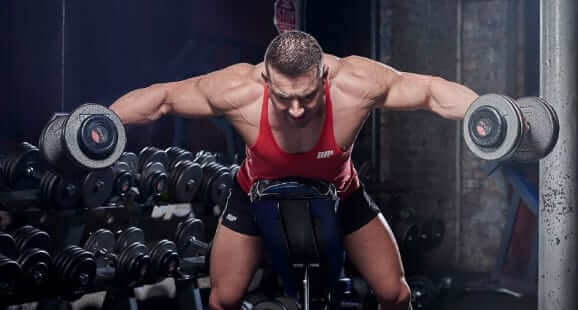
Tips for working out your shoulders with weights
Before diving into the exercises above, make sure you read these following notes:
- Overworking your muscles isn’t beneficial: a moderate exercise is the best routine for shoulders. Instead of tackling more exercises, do fewer with weights instead. Pushing yourself past your limits doesn’t promise progress. On the contrary, it could lead to injuries.
- Work out your trapezius: on your delt day, consider adding a fifth exercise for your trapezius. Start by grabbing your dumbbells or a bar with your arms extended downwards. After, slowly lift them with your shoulders.
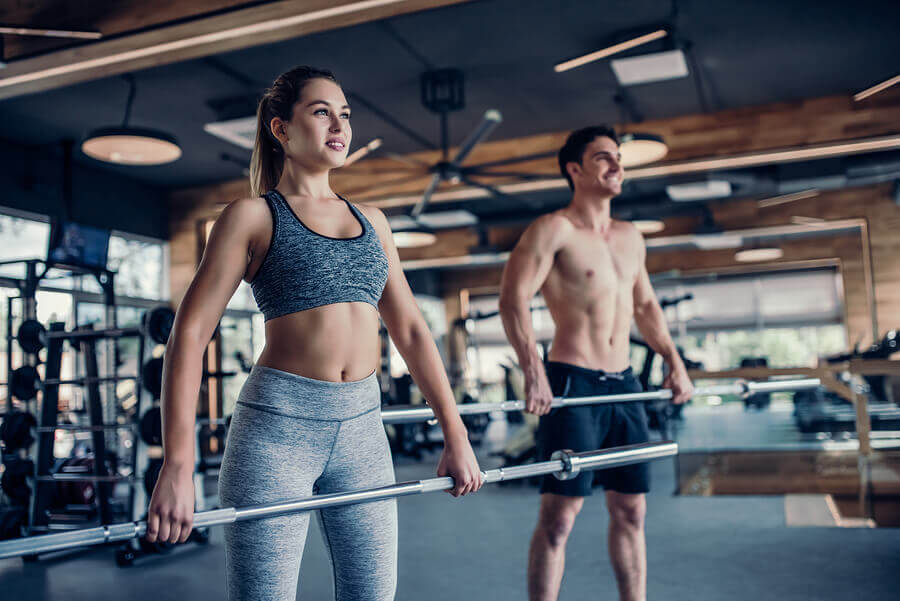
- Avoid rotating your shoulders: Even today, some shoulder exercises require a rotating motion. But they’re not very recommendable and not many people do them. If anything, they can help in strength-building sessions for the rotator cuff.
To wrap up, remember to take the necessary precautions when doing these exercises. Remember, slow and steady wins the race! Aim for gradual progress in your workouts.
Defined shoulders look great. Aside from their physical appearance, strengthening them is helpful for performing other exercises better, such as back exercises. Weight-training is the best way to work out your shoulders.
But working them out isn’t easy. Some people find the positions in shoulder exercises rather uncomfortable. In addition, incorrect execution can lead to painful injuries. In light of that, today we’ll look closer at weight-training exercises for shoulders.
Weight-training exercises for shoulders
You actually don’t need to do that many exercises for strong deltoid muscles. Let’s look at a list of exercises that make up a great weight-training workout.
Neutral grip overhead press
Some of the best shoulder workouts are seated. The neutral grip overhead press is a variation of a classic shoulder workout. To get started, sit down and grab your dumbbells. Raise your arms to the height of your chest.
In these exercises, make sure that both of your palms are always face-to-face. That position is the key variable that works out the front section of your deltoid muscles. Next, raise the dumbbells, extending your arms. Your elbows should be pointing slightly outwards.
Lift the weight by extending your arms and lower it by bending them. In the starting position, your dumbbells should always be in front of your chest while your arms should be completely bent.

Dumbbell Arnold press
For the Arnold press, stay seated and in the same position as the previous exercise. The difference is in the position of your hands in relation to your dumbbells.
Here, both palms should be facing backwards. Think about the movement you make when you work out your biceps.
Start with your arms bent and dumbbells just above your shoulders. Next, lift them by twisting your wrists. When your arms are extended, your palms should be facing outwards.

The advantage of this position and twist is that they allow you to almost entirely work out your deltoid muscles. It’s an integral exercise, unlike the traditional ones where the arms stay up and the shoulders only have a superficial workout.
Frontal lifts
Frontal lifts can’t be missing from your shoulder workout; it really focuses on the muscle set. Everyone has probably seen frontal lifts at some point or another in a gym.
To get started, stand up as straight as possible. In the starting position, keep the dumbbells lowered as you completely extend your arms. Try to keep them alongside your legs.
Next, raise your arms, keeping them as straight as possible and control the weight of the dumbbell. Raise and lower your arms, controlling both actions. This routine really builds the strength you’ll need to tackle your other shoulder workouts.

Lateral lifts with inclined core
Lastly, we have to include at least one exercise for the back of your shoulders. Skipping over the backside is a common mistake people make in their shoulder routines.
Start by leaning your core forwards and keeping it as straight as possible. Remember to keep your neck as still as possible throughout the exercise to prevent any muscle pain or injuries.
Now, lift your dumbbells, extending both of your arms outwards. You should be slightly bending your elbows and legs to hold the weight and stay in the same position.

Tips for working out your shoulders with weights
Before diving into the exercises above, make sure you read these following notes:
- Overworking your muscles isn’t beneficial: a moderate exercise is the best routine for shoulders. Instead of tackling more exercises, do fewer with weights instead. Pushing yourself past your limits doesn’t promise progress. On the contrary, it could lead to injuries.
- Work out your trapezius: on your delt day, consider adding a fifth exercise for your trapezius. Start by grabbing your dumbbells or a bar with your arms extended downwards. After, slowly lift them with your shoulders.

- Avoid rotating your shoulders: Even today, some shoulder exercises require a rotating motion. But they’re not very recommendable and not many people do them. If anything, they can help in strength-building sessions for the rotator cuff.
To wrap up, remember to take the necessary precautions when doing these exercises. Remember, slow and steady wins the race! Aim for gradual progress in your workouts.
All cited sources were thoroughly reviewed by our team to ensure their quality, reliability, currency, and validity. The bibliography of this article was considered reliable and of academic or scientific accuracy.
- Miguel Vélez Blasco. Ejercicios de carga natural. 2003. Extraído de: http://fcatletisme.cat/wp-content/uploads/elsexercicisdecarreganatural.pdf
- Miguel Vélez Blasco. Apéndice de ejercicios con sobrecargas. Extraído de: http://fcatletisme.cat/wp-content/uploads/els50exercicisdeforsamesutilitzats.pdf
This text is provided for informational purposes only and does not replace consultation with a professional. If in doubt, consult your specialist.








